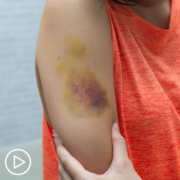Why Does Bruising Occur in Chronic Lymphocytic Leukemia?
Why Does Bruising Occur in Chronic Lymphocytic Leukemia? from Patient Empowerment Network on Vimeo.
Bruising is a chronic lymphocytic leukemia (CLL) side effect in some patients, but why does it happen? Expert Dr. Ryan Jacobs explains different reasons that bruising may occur more easily in CLL patients.
Dr. Ryan Jacobs is a hematologist/oncologist specializing in chronic lymphocytic leukemia from Levine Cancer Institute. Learn more about Dr. Jacobs.
Related Programs:

|

Why Is Early Stage Chronic Lymphocytic Leukemia Treatment Delayed? |

|
Transcript:
Lisa Hatfield:
What causes persistent bruising? Are there more side effects from vaccines that have been discovered recently that were not discovered initially?
Dr. Jacobs:
Yeah. So there are a lot of different things that can cause bruising in a CLL patient. I think one thing that’s just worth noting is that we bruise easier as we get older. Our skin tends to thin, and often older patients are on medicines that interfere with platelet aggregation, and maybe even they’re on blood thinners. So, of course, all those things can contribute to bruising. CLL is a cancer of the aging patient population, average age 70, 71.
So these are patients that are going to be noting more easy bruising in general. But what are the CLL-specific factors that can lead to increased bruising? I would highlight, if patients are having decreasing platelet counts because of bone marrow involvement. And then the…what the second part of this question addresses is the use of Bruton tyrosine kinase inhibitors, specifically and the covalent Bruton tyrosine kinase inhibitors like ibrutinib (Imbruvica), acalabrutinib (Calquence), and zanubrutinib (Brukinsa). They all in varying ways, have been shown to lead to increased bruising and potentially bleeding. And they do tend to interact with the platelets in a way that leads to some dysregulation in platelet aggregation.
Share Your Feedback
Create your own user feedback survey










